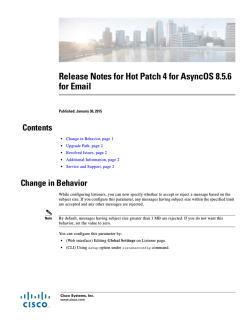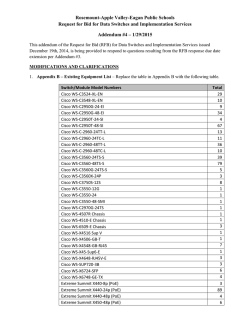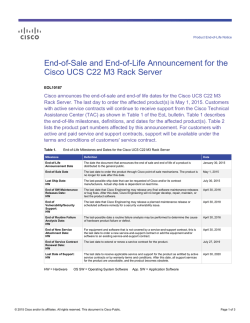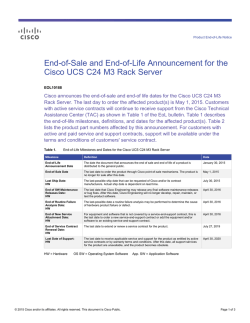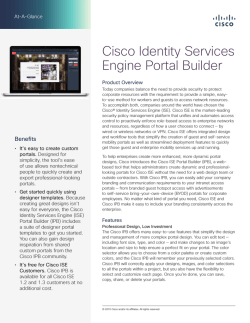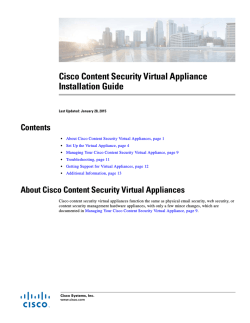
Cisco AsyncOS 9.0 for Email Release Notes
Release Notes for Cisco AsyncOS 9.0 for Email Published: January 28, 2015 Contents • What’s New, page 2 • Changes in Behavior, page 5 • Documentation Updates, page 6 • Upgrade Paths, page 7 • Installation and Upgrade Notes, page 7 • Known and Fixed Issues, page 11 • Related Documentation, page 13 • Service and Support, page 13 Cisco Systems, Inc. www.cisco.com What’s New What’s New Feature Description New Features Release and Support Notifications You can now receive software release and critical support notifications from Cisco Support (in the form of alerts). S/MIME Security Services AsyncOS for Email now allows organizations to communicate securely using S/MIME without requiring that all end-users possess their own certificates. Organizations can handle message signing, encryption, verification, and decryption at the gateway level using certificates that identify the organization rather than the individual. AsyncOS provides the following S/MIME security services: Cisco AsyncOS API for Email • Sign, encrypt, or sign and encrypt messages using S/MIME • Verify, decrypt, or decrypt and verify messages using S/MIME The Cisco AsyncOS API for Email (or AsyncOS API) is a Representational StateTransfer (REST)-based set of operations that provide secure and authenticated access to the Email Security appliance reports and report counters. You can retrieve the Email Security appliance reporting data using this API. See Cisco AsyncOS API for Email - Getting Started Guide. File Analysis Quarantine AsyncOS for Email now includes an Advanced Malware Protection-specific quarantine. You can configure the appliance to quarantine messages with attachments sent for analysis. Enhancements Virtual Appliance enhancements • Support for thin provisioning • Support for ESXi 5.5 • Access to more than 2 TB of disk space However, when upgrading a virtual appliance, an important caveat applies. See Upgrading a Virtual Appliance, page 8. Customizable disk space You can now allocate disk space on the appliance based on the functionality your organization uses (spam and system quarantines, reporting and tracking data, etc.) Previous limits on quarantine size have been removed. For virtual appliances, you can use VMWare tools to increase the disk space available to Email Security appliance instances. However, in order to access more than 2 TB of disk space on upgraded virtual appliances, see Upgrading a Virtual Appliance, page 8. If you are upgrading, see also Optimize Disk Space Allocations, page 11. Release Notes for Cisco AsyncOS 9.0 for Email 2 What’s New Feature Description More flexibility for choosing users for an incoming or outgoing policy Prior to this release, an incoming or outgoing policy matches if any of the specified values (sender, receiver domains, or LDAP group names) in the policy matches. Cisco AsyncOS 9.0 for Email provides you more flexibility for choosing users for an incoming or outgoing policy. You can set the policy to match if, • The message is from any sender, one or more of the specified senders, or none of the specified senders. • The message is sent to any recipient, one or more of the specified recipients, or all of the specified recipients and none of the specified recipients. Note Advanced Malware Protection Improvements • From Cisco AsyncOS 9.0 for Email onwards, you must set at least one sender and recipient. You can now use the Advanced Malware Protection feature to detect malware in archived or compressed email attachments. For a list of supported archive and compressed formats, see File Criteria for Advanced Malware Protection Services for Cisco Content Security Products. • When you configure the file analysis feature, you choose which file types are sent for analysis. For a list of supported file types, see File Criteria for Advanced Malware Protection Services for Cisco Content Security Products. • New types are added dynamically; you will receive an alert when the list of uploadable file types changes, and can select added file types to upload. • You will receive an alert if analysis of some file types is temporarily unavailable. • You will receive an alert if analysis of all supported file types is restored after a temporary outage. • Cisco AsyncOS for Email now includes a new message filter action (skip-ampcheck) that allows messages to bypass File Reputation Filtering and File Analysis configured on the system. Virtual gateway improvement The number of Virtual Gateway addresses available on all Email Security appliance models is now 255. Per-user spam notifications You can specify which users receive spam notifications, based on LDAP groups. Customizable end user notification page for URL filtering You can customize the appearance of the end user notification page used for URL filtering and display your organization's branding such as logo, name of the organization, contact information, and so on. Enhanced password options When creating user accounts or changing passwords, there is now an option to auto-generate a password that meets the configured requirements. Release Notes for Cisco AsyncOS 9.0 for Email 3 What’s New Feature Description Welcome banner to display internal security information or best practice instructions for the appliance You can configure Cisco AsyncOS for Email to display a welcome banner after a user successfully logs into the appliance through SSH, Telnet, FTP, or web interface. You can use the welcome banner to display internal security information or best practice instructions for the appliance. New authorization protocol for outgoing SMTP authentication Outgoing SMTP authentication now supports the following additional authorization protocol: LOGIN. Enhanced spam protection capabilities Cisco AsyncOS now has enhanced capabilities to detect and protect against new spam campaigns, for example, snowshoe spam. Enhanced logic to To avoid false alerts, the logic used to detect whether AMP services (File detect whether AMP Reputation and Analysis) are reachable is enhanced. services (File Reputation and Analysis) are reachable Configurable SSL Settings in FIPS Mode In FIPS mode, you can now configure the Cipher Suites in the SSL settings, using the sslconfig command in CLI. For more information, see Cisco AsyncOS for Email CLI Reference Guide. Note Configurable SSH Server Settings Encrypt sensitive data in FIPS mode You cannot change server and client methods in FIPS mode. You can now configure the following SSH server settings using the sshconfig command in CLI: • Public Key Authentication Algorithms • Cipher Algorithms • KEX Algorithms • MAC Methods • Minimum Server Key Size In FIPS mode, you can now encrypt: • Critical security parameters in your appliance • Swap space in your appliance. This helps to prevent any unauthorized access or forensic attacks when the physical security of the appliance is compromised. Use the fipsconfig command in CLI to enable encryption of sensitive data in the appliance. Encrypt sensitive data in configuration files You can now encrypt the critical security parameters in the appliance configuration file while exporting, emailing, or displaying it. Permanently delete sensitive data in the appliance You can now permanently delete sensitive data (critical security parameters) in your appliance using one of the following commands in CLI: • wipedata • diagnostic > reload See Cisco AsyncOS for Email CLI Reference Guide. Release Notes for Cisco AsyncOS 9.0 for Email 4 Changes in Behavior Feature Description More secure AsyncOS updates and upgrades For enhanced security, AsyncOS now uses a stronger hashing algorithm, SHA-384, to verify the received updates and upgrades. Configurable CLI Session Timeout You can now specify how long a user can be logged into the Email Security appliance’s CLI before AsyncOS logs the user out due to inactivity. Note The CLI session timeout applies only to the connections using Secure Shell (SSH), SCP, and direct serial connection. Enhanced security for For enhanced security, if encryption of sensitive data in the appliance is DKIM Signing Keys in enabled in FIPS mode, FIPS mode • Private keys are not displayed in plain text while editing an existing signing key. • Signing keys are encrypted while exporting. Enhanced security for For enhanced security, in FIPS mode, AsyncOS for Email uses a 2048-bit DSA Host Keys in FIPS DSA host key. mode Enhanced security for Demonstration Certificate The demonstration certificate is updated to use keys of size 2048 bits and 1024 bits for FIPS mode and non-FIPS mode, respectively. Enhanced URL Defanging Message and content filters for URL defanging now accounts for DNS spoofing and replaces a “.” (dot) in the URL with “[.]”. For example, after defanging, www.defangurl.com becomes BLOCKEDwww[.]defangurl[.]comBLOCKED. Changes in Behavior • Deprecated Commands, page 5 • Disk Space for Quarantines, page 5 • Changes in Password Change Options, page 6 • Changes in Local User Account and Password Settings, page 6 • Opening a Support Case from the Appliance, page 6 • New Log for URL Filtering, page 6 • Stricter Password Rules, page 6 Deprecated Commands The disk_usage subcommand under diagnostics has been deprecated. To view and configure disk space quotas, use the diskquotaconfig command instead. Disk Space for Quarantines You must now allocate disk space for quarantines using the System Administration > Disk Management menu. Release Notes for Cisco AsyncOS 9.0 for Email 5 Documentation Updates Changes in Password Change Options When you are enforcing a password change, you can choose whether the users must change the password during the next login or after a specified duration. If you are enforcing a password change after a specified duration, you can also set a grace period to reset the password after the password expires. Changes in Local User Account and Password Settings While configuring Local User Account and Password Settings, you can configure a grace period to reset the password after the password expires. Opening a Support Case from the Appliance In order to open a support case from the appliance, you will need your CCOID and support contract number. Previously, this information was collected via other means. Also, in order to route cases more efficiently, the Technology and Sub-Technology options may differ from previous releases and may change at any time. New Log for URL Filtering URL filtering information will be posted to the following logs: • Mail Logs (mail_logs). Information related to the result of scanning a URL (action taken of a message depending on the URL) is posted to this log. • URL Filtering Logs (web_client). Information related to errors, timeouts, network issues, and so on while attempting the URL lookup are posted this log. Stricter Password Rules Stricter password rules are enforced immediately after running the System Setup Wizard. Documentation Updates Note For the most current and complete documentation, see the PDF version of the user guide for AsyncOS for Cisco Email Security Appliances. Online help may not include the most current and complete information. • The maximum depth of attachment recursion to scan (configured using Scan Behavior page or scanconfig command in CLI) is 50. In the online help, this value is incorrect. • References in Online Help to Unsupported Hardware Models. Please disregard references in the online help to any hardware models that are not supported in this release. Release Notes for Cisco AsyncOS 9.0 for Email 6 Upgrade Paths Upgrade Paths Important! See the following sections before upgrading: • Hardware appliances: This release is supported only on certain models. See Supported Hardware for This Release, page 7. • Virtual appliances: To ensure that you obtain all of the benefits of this release, see Upgrading a Virtual Appliance, page 8. • Cluster configurations (centralized management): Take action before you upgrade your cluster. See Upgrading Deployments with Centralized Management (Clustered Appliances), page 8. • To ensure a successful upgrade: You must complete some steps before you start the upgrade process. For details on these prerequisites, see “Installation and Upgrade Notes” section on page 7. You can upgrade to release 9.0.0-500 from the following versions: • 8.0.1-023 • 8.5.6-092 • 8.5.6-106 • 8.6.0-050 • 9.0.0-448 Installation and Upgrade Notes Read through and consider the installation and upgrade impacts listed in this section. When you upgrade AsyncOS for Email from the web interface or Command Line Interface (CLI), the configuration is saved to file in the /configuration/upgrade directory. You can access the upgrade directory using an FTP client. Each configuration file name is appended with the version number, and passwords in the configuration file are masked so they are not human readable. You must be logged in as the admin to upgrade. Also, you must reboot the appliance after upgrading. Supported Hardware for This Release The following hardware is NOT supported for this release: C160, C360, C660, and X1060 Deploying or Upgrading a Virtual Appliance If you are deploying or upgrading a virtual appliance, see the Cisco Content Security Virtual Appliance Installation Guide. Release Notes for Cisco AsyncOS 9.0 for Email 7 Installation and Upgrade Notes Upgrading a Virtual Appliance If you have a previous Email Security Virtual Appliance release and you want to use more than 2 TB of disk space, you cannot simply upgrade your virtual appliance. Instead, deploy a new virtual machine instance for this release. You can maintain the old instance separately, and optionally manage both instances using a Cisco Content Security Management appliance. When you upgrade a virtual appliance, the existing licenses remain unchanged. Migrating from a Hardware Appliance to a Virtual Appliance Step 1 Set up your virtual appliance with this AsyncOS release using the documentation described in Deploying or Upgrading a Virtual Appliance, page 7. Step 2 Upgrade your hardware appliance to this AsyncOS release. Step 3 Save the configuration file from your upgraded hardware appliance Step 4 Load the configuration file from the hardware appliance onto the virtual appliance. Getting Technical Support for Virtual Appliances Requirements for obtaining technical support for your virtual appliance are described in the Cisco Content Security Virtual Appliance Installation Guide Provisioning and Activating Cisco Registered Envelope Service Administrator from Virtual Appliances Please contact Cisco TAC for information required to provision your virtual appliance. Automatic provisioning for virtual appliances is not supported in this release. Instead, send an email to [email protected] with your serial number and Admin email address. Upgrading Deployments with Centralized Management (Clustered Appliances) If a cluster includes C160, C360, C660, or X1060 hardware appliances, remove these appliances from the cluster before upgrading. All machines in a cluster must be running the same version of AsyncOS, and x60 hardware cannot be upgraded to this release. If necessary, create a separate cluster for your x60 appliances. Pre-upgrade Notes Please be aware of the following upgrade impacts: • Email Authentication, page 9 • Configuration Files, page 9 • Received Headers, page 9 • Feature Keys, page 9 Release Notes for Cisco AsyncOS 9.0 for Email 8 Installation and Upgrade Notes • Resource Conservation Mode, page 9 • DLP Policies on RSA Enterprise Manager, page 10 • File Analysis Quarantine, page 10 Email Authentication For DKIM Authentication, Cisco currently supports version 8 of the Draft Specification of ‘Authentication-Results:’ header. For SPF/SIDF verification, the spf-passed rule is no longer available in content filters. To maintain backwards compatibility, the spf-passed content filter rule will be accepted from XML configuration files but it will be converted to the spf-status rule with corresponding arguments. spf-passed will be changed to spf-status == "Pass" and NOT spf-passed to spf-status != "Pass". You can, however, still use the spf-passed message filter. Configuration Files Cisco does not generally support the backward compatibility of configuration files with previous major releases. Minor release support is provided. Configuration files from previous versions may work with later releases; however, they may require modification to load. Check with Cisco Customer Support if you have any questions about configuration file support. Received Headers When you configure AsyncOS to use received headers, you can specify that the header reflects one of the following hostnames: • The hostname of the Virtual Gateway used for delivering the message • The hostname of the interface the message is received on You specify the hostname from the CLI command listenerconfig-> setup. You cannot configure the hostname from the web interface. If you configure the received header to display the hostname of the interface the message is received on, a strip-header filter action configured to strip received headers will strip the received header inserted by AsyncOS. Feature Keys The AsyncOS appliance checks for and applies feature keys at one minute intervals. Therefore, when you add a feature key, it may take up to a minute to view the changes. Resource Conservation Mode From AsyncOS 8.5.x for Email, Email Security appliance will enter resource conservation mode when the RAM utilization exceeds 45% and the allowed injection rate is gradually decreased as RAM utilization approaches 60%. Appliances with large memory utilization, especially with large system quarantine, can enter resource conservation immediately after upgrading to AsyncOS 8.5.x for Email. To avoid this scenario, make sure that you reduce the system quarantine to a few thousand messages before upgrading. Release Notes for Cisco AsyncOS 9.0 for Email 9 Installation and Upgrade Notes DLP Policies on RSA Enterprise Manager If you are using RSA Enterprise Manager to manage DLP policies, after upgrading to AsyncOS 9.0 for Email, the association of the policies on RSA Enterprise Manager with Mail Policies on AsyncOS breaks. This is because, in AsyncOS 9.0 for Email, Mail Policies are handled differently from the previous releases. To overcome this scenario, you must reassociate the DLP policies on RSA Enterprise Manager with Mail Policies on AsyncOS. For instructions, refer Chapter 17, “Data Loss Prevention” of Cisco AsyncOS for Email User Guide. File Analysis Quarantine If your appliance already has a user created policy quarantine with the name "File Analysis," after upgrading to Cisco AsyncOS 9.0 for Email, the system quarantine for File Analysis is not created due to the name conflict. In this scenario, before upgrading to Cisco AsyncOS 9.0 for Email, you must rename the user created policy quarantine. Upgrading to This Release Before You Begin • Review the Known Issues, page 11 and Installation and Upgrade Notes, page 7. • If you are upgrading a virtual appliance, see Upgrading a Virtual Appliance, page 8. Procedure Use the following instructions to upgrade your Email Security appliance. Step 1 Save the XML configuration file off the appliance. Step 2 If you are using the Safelist/Blocklist feature, export the Safelist/Blocklist database off the appliance. Step 3 Suspend all listeners. Step 4 Wait for the queue to empty. Step 5 From the System Administration tab, select the System Upgrade page. Step 6 Click the Available Upgrades button. The page refreshes with a list of available AsyncOS upgrade versions. Step 7 Click the Begin Upgrade button and your upgrade will begin. Answer the questions as they appear. Step 8 When the upgrade is complete, click the Reboot Now button to reboot your appliance. Step 9 Resume all listeners. Step 10 (Only if DLP Policies are managed using RSA Enterprise Manager) Reassociate the DLP policies on RSA Enterprise Manager with Mail Policies on AsyncOS. See DLP Policies on RSA Enterprise Manager, page 10. Release Notes for Cisco AsyncOS 9.0 for Email 10 Known and Fixed Issues After Upgrading Optimize Disk Space Allocations After upgrade is complete, you can go to System Administration > Disk Management and optimize disk space allocation for the functionality that your deployment uses. Note After upgrading, if you receive an alert stating that the Miscellaneous disk usage has approached 75 percent of the quota, you must manually set the disk space for Miscellaneous to 30 GB. This problem occurs if you have upgraded to Cisco AsyncOS 9.0 for Email more than three times. Performance Advisory RSA Email DLP - Enabling RSA Email DLP for outbound traffic on an appliance that is also running anti-spam and anti-virus scanning on inbound traffic can cause a performance decrease of less than 10%. Appliances that are only running outbound messages and are not running anti-spam and anti-virus may experience a significant performance decline. SBNP - SenderBase Network Participation now uses the Context Adaptive Scanning Engine (CASE) to collect data to power IronPort Information Services. In some configurations customers may experience a moderate performance decline. Outbreak Filters - Outbreak Filters uses the Context Adaptive Scanning Engine to determine the threat level of a message and scores messages based on a combination of Adaptive Rules and Outbreak Rules. In some configurations, you may experience a moderate performance decline. IronPort Spam Quarantine - Enabling the IronPort Spam Quarantine on-box for a C-Series or X-Series appliance causes a minimal reduction in system throughput for nominally loaded appliances. For appliances that are running near or at peak throughput, the additional load from an active quarantine may cause a throughput reduction of 10-20%. If your system is at or near capacity, and you desire to use the IronPort Spam Quarantine, consider migrating to a larger C-Series appliance or an M-Series appliance. If you change your anti-spam policy from dropping spam to quarantining it (either on-box or off-box), then your system load will increase due to the need to scan additional spam messages for virus and content security. For assistance in properly sizing your installation please contact your authorized support provider. Known and Fixed Issues Use the Cisco Bug Search Tool to find information about known and fixed defects in this release. • Bug Search Tool Requirements, page 12 • Lists of Known and Fixed Issues, page 12 • Finding Information about Known and Resolved Issues, page 12 Release Notes for Cisco AsyncOS 9.0 for Email 11 Known and Fixed Issues Bug Search Tool Requirements Register for a Cisco account if you do not have one. Go to https://tools.cisco.com/RPF/register/register.do. Lists of Known and Fixed Issues Fixed Issues https://tools.cisco.com/bugsearch/search?kw=*&pf=prdNm&pfVal =282509130&prdNam=Cisco%20Email%20Security%20Applianc e&rls=9.0.0&sb=fr&srtBy=byRel&bt=custV Known Issues https://tools.cisco.com/bugsearch/search?kw=*&pf=prdNm&pfVal =282509130&rls=9.0.0&sb=anfr&sts=open&svr=3nH&srtBy=by Rel&bt=custV Finding Information about Known and Resolved Issues Use the Cisco Bug Search Tool to find the most current information about known and resolved defects. Before You Begin Register for a Cisco account if you do not have one. Go to https://tools.cisco.com/RPF/register/register.do. Procedure Step 1 Go to https://tools.cisco.com/bugsearch/. Step 2 Log in with your Cisco account credentials. Step 3 Click Select from list > Security > Email Security > Cisco Email Security Appliance, and click OK. Step 4 In Releases field, enter 9.0.0. Step 5 Depending on your requirements, do one of the following: Note • To view the list of resolved issues, select Fixed in these Releases from the Show Bugs drop down. • To view the list of known issues, select Affecting these Releases from the Show Bugs drop down and select Open from the Status drop down. If you have questions or problems, click the Help or Feedback links at the top right side of the tool. There is also an interactive tour; to view it, click the link in the orange bar above the search fields. Release Notes for Cisco AsyncOS 9.0 for Email 12 Related Documentation Related Documentation Documentation For Cisco Content Security Products Location Hardware and virtual appliances See the applicable product in this table. Cisco Content Security Management http://www.cisco.com/c/en/us/support/security/content-security -management-appliance/tsd-products-support-series-home.html Cisco Web Security http://www.cisco.com/c/en/us/support/security/web-security-ap pliance/tsd-products-support-series-home.html Cisco Email Security http://www.cisco.com/c/en/us/support/security/email-security-a ppliance/tsd-products-support-series-home.html CLI reference guide for Cisco Content Security appliances http://www.cisco.com/c/en/us/support/security/email-security-a ppliance/products-command-reference-list.html Cisco IronPort Encryption http://www.cisco.com/c/en/us/support/security/email-encryptio n/tsd-products-support-series-home.html Service and Support Use the following methods to obtain support: U.S.: Call 1 (408) 526-7209 or Toll-free 1 (800) 553-2447 International: http://www.cisco.com/en/US/support/tsd_cisco_worldwide_contacts.html Support Site: http://www.cisco.com/en/US/products/ps11169/serv_group_home.html This document is to be used in conjunction with the documents listed in the “Related Documentation” section. Cisco and the Cisco logo are trademarks or registered trademarks of Cisco and/or its affiliates in the U.S. and other countries. To view a list of Cisco trademarks, go to this URL: www.cisco.com/go/trademarks. Third-party trademarks mentioned are the property of their respective owners. The use of the word partner does not imply a partnership relationship between Cisco and any other company. (1110R) Any Internet Protocol (IP) addresses and phone numbers used in this document are not intended to be actual addresses and phone numbers. Any examples, command display output, network topology diagrams, and other figures included in the document are shown for illustrative purposes only. Any use of actual IP addresses or phone numbers in illustrative content is unintentional and coincidental. © 2015 Cisco Systems, Inc. All rights reserved. Release Notes for Cisco AsyncOS 9.0 for Email 13
© Copyright 2024
